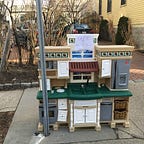We’re making real-time bus locations more “real”
Let’s begin with a little MBTA history.
8+ years ago, the MBTA introduced a pilot of NextBus real-time location information and predictions on 5 bus routes.
It was a convoluted process. Bus location information came from our Computer Aided Dispatch/Automated Vehicle Location system, TransitMaster, to a server hosted in our on-premises data center, then to our partner, NextBus. Along the way, latency was added, so a bus update had about 30 seconds of latency in it.
We’re super proud that in the ensuing years we’ve extended real-time predictions across much of the MBTA, improving commutes for riders using our website and a whole ecosystem of apps. But, for buses, it’s basically the same tech platform, except we now send the data to an application that runs our API.
Not pretty, but it works. Except …
It intersects with another less-than-ideal process. The MBTA’s real-time GPS feed comes over our systemwide radio. Our systemwide radio is old and low bandwidth, so we only get a ping every 60 seconds. And, if an operator is using their radio as a, well, radio, we get no data. That’s a problem.
Take this example: If a bus is stopped for 5 minutes because of an issue, the operator is usually on the radio with dispatchers at the control center. From our system’s perspective, though, the bus could still be moving — bus drivers use their radios while driving, too. All we know is that the location was last updated 5 minutes ago. So from a predictive standpoint, we think it’s 5 minutes closer to you. That’s not so good.
What if you wanted to fix all that?
What if you had data on where buses were every few seconds? You could watch them come toward you. You could know if they were stopped at a light, or stuck in traffic. You could make your own judgements on how close they were, and how long you would wait.
With “real” real-time data, we could improve the quality of our predictions — less time waiting 5 minutes for a bus that says it’s only 2 minutes away, because we don’t have a fine enough level of detail to make a better prediction.
If you wanted to fix it you’d need to do a few things.
First, you’d need to build a system that could pull data in from sources other than TransitMaster. We did: its called Busloc. (And we just released it!)
Second, you’d need to purchase other devices that could report locations more frequently than once a minute. We did. We’re running a pilot with 6 buses that have small, inexpensive devices in them that report back bus location, heading, and speed every few seconds over cellular. (And other cool stuff like engine status which will help us maintain buses better.)
Combine those 2, and you have a feed that for the first time has 6 buses (out of a fleet of more than 1000) that update every few seconds, with much lower latency. Its here. (all 6 buses may not be in service at any given time.)
Over the next few months we expect to be able to expand this to our entire fleet. That right: “real” real-time locations for the entire MBTA bus fleet. Coming soon.
Bonus third: We’ve released a Request For Proposal for a new bus arrival prediction system. It’s in the middle of procurement so its totally top secret. (Procurement nerds can read the RFP.) The tl;dr is we’re competing on prediction quality, using these feeds. Our riders deserve better bus arrival predictions. And the best way to get them is to use a company that has demonstrated it can produce the best predictions by actually providing them on our buses. This is the first time any mass transit agency has done this, to our knowledge. And we plan on releasing the results in a few months, after we’ve awarded the contract and it doesn’t jeopardize the integrity of the bidding process. Much more on that to come.
To summarize.
- Any frequency of real-time location data is better than none.
- The closer we get to “real” real-time, the more confident our riders can be that their bus is actually coming.
- The “realer” the data, the better the arrival predictions.
- Not having to wait as long is just one component of Better Buses.
- We’re doing it. Not in 5 years. Before it snows again.
We’re building amazing things to make riding the bus better, and a whole lot more. Come join us.
